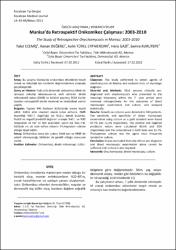| dc.contributor.author | Ecemiş, Talat | |
| dc.contributor.author | Değerli, Kenan | |
| dc.contributor.author | Türel Ertmercan, Aylin | |
| dc.contributor.author | Gazi, Hörü | |
| dc.contributor.author | Kurutepe, Semra | |
| dc.date.accessioned | 2021-05-05T22:17:18Z | |
| dc.date.available | 2021-05-05T22:17:18Z | |
| dc.date.issued | 2013 | |
| dc.identifier.issn | 1302-4612 | |
| dc.identifier.issn | 2149-7869 | |
| dc.identifier.uri | https://app.trdizin.gov.tr/makale/TVRVek16WTBOQT09 | |
| dc.identifier.uri | https://hdl.handle.net/20.500.12933/712 | |
| dc.description.abstract | Amaç: Bu çalışma Manisa’da onikomikoz etkenlerini tespit etmek ve mikolojik tanı testlerini değerlendirmek amacıyla gerçekleştirildi. Gereç ve Yöntem: Yedi yıllık dönemde onikomikoz klinik ön tanısıyla mikoloji laboratuvarına sevk edilerek direkt mik- roskobik bakısı (DMB) ve kültürü yapılmış 3518 kişinin kayıt- ları retrospektif olarak incelendi ve istatistiksel analizi yapıl- dı. Bulgular: Toplam 940 hastanın kültüründe üreme tespit edildi. Kültür altın standart olarak kabul edilerek, DMB duyarlılığı %87.7, özgüllüğü ise %52.2 olarak bulundu. Pozi- tif ve negatif prediktif değerler sırasıyla %40.1 ve %92 he- saplandı ve her iki test arasındaki uyum ise %61.7’di. Kül- türde en sık izole edilen etkenin Trichophyton rubrum oldu- ğu tespit edildi. Sonuç: Onikomikoz tanısı için sadece klinik tanı ve DMB’nin yeterli olamayacağı, kültürün de gerekli olduğu sonucuna varıldı. | en_US |
| dc.description.abstract | Objective: This study performed to detect agents of onychomycosis in Manisa and evaluate tests of mycologic diagnosis. Material and Methods: 3518 persons clinically pre- diagnosed with onychomycosis who presented to the mycology laboratory within the 7- year period were reviewed retrospectively for the outcomes of direct microscopic examination and culture, and analysed statistically. Results: Growth on cultures were detected in 940 patients. The sensitivity and specificity of direct microscopic examination using culture as a gold standard were found 87.7% and 52.2% respectively. The positive and negative predictive values were calculated 40.1% and 92% respectively and the concordance in both tests was 61.7%. Trichopyhton rubrum was the agent most frequently isolated on culture. Conclusion: It was concluded that only clinical pre-diagnosis and direct microscopic examination alone cannot be sufficient and culture is also required. | en_US |
| dc.language.iso | tur | en_US |
| dc.rights | info:eu-repo/semantics/openAccess | en_US |
| dc.subject | Biyoteknoloji ve Uygulamalı Mikrobiyoloji | en_US |
| dc.subject | Hematoloji | en_US |
| dc.subject | Mikrobiyoloji | en_US |
| dc.title | Manisa'da retrospektif onikomikoz çalışması: 2003-2010 | en_US |
| dc.title.alternative | The study of retrospective onychomycosis in manisa: 2003-2010 | en_US |
| dc.type | article | en_US |
| dc.department | AFSÜ | en_US |
| dc.identifier.volume | 14 | en_US |
| dc.identifier.issue | 2 | en_US |
| dc.identifier.startpage | 64 | en_US |
| dc.identifier.endpage | 67 | en_US |
| dc.relation.journal | Kocatepe Tıp Dergisi | en_US |
| dc.relation.publicationcategory | Makale - Ulusal Hakemli Dergi - Başka Kurum Yazarı | en_US |
















